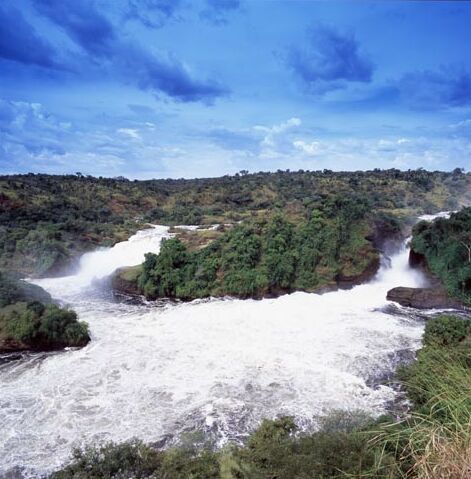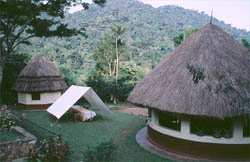Localities and lodging
Uganda
Entebbe
Entebbe is a laid-back summer lake resort along the Lake Victoria. It
was the administrative capital of Uganda in the colonial era. It has the only
international airport in Uganda.
Accommodation:
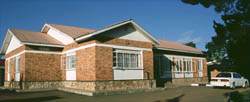
Golf View Inn.
Small but clean s/c rooms
with a hot bath, rather overpriced but not bad value for Entebbe. Acceptable
restaurant and a shady garden bar. (Category: budget).
or
Central Inn.
Mabira Forest Reserve
Extending over more than 300km2 this reserve straddles the
Kampala–Jinja road about 20km west of Jinja, and 55 from Kampala. It is
primarily composed of moist semi-deciduous forest, with more than 200
identified tree species. There is also grasslands and papyrus swamps. A lot of
the forest was destroyed in the colonial era and in the Amin era. But since
1988 it has recovered well through replanting of indigenous tress, and the
illegal felling has practically ceased.
There is an excellent network of forest trails emanating from the
visitors centre, with good birding. Over 300 species has been recorded. There
is a local bird guide, Ibrahim Senfuma.
Soroti
Soroti, with a
population of 42 000, is the headquarter of a district of the same name. It is
mainly populated by Iseto people. There is a good number of trucks that rumble
through town, we are on the main drag to the Sudan border, and apparently
southern Sudan is going through a building boom now that the fighting has
stopped and they are semi-autonomous. You also see lots of World Food Program
trucks heading for the north of Uganda with food for the IDP camps.
Accommodation:
Soroti Hotel. Tel 0414 561269. Recently
renovated hotel in pleasant grounds about 1 km out of town.
There are about 10
other places to stay in town, for example the Golden Ark and the Garden
Guesthouse.
Lake Bisina
This is where the only
truly endemic bird species of Uganda occur, the Fox’s Weaver.
Masindi
Masindi is a sleepy
small town of 15 000 inhabitants and the gateway to Murchison Falls and Budongo
Forest. During the colonial era it was a busy hub between Uganda, DRC, Sudan
and the railway to Mombasa. Now the border to DCR is closed, and north
westernmost Uganda an area of unrest. Recently the border to Sudan has opened again;
maybe this will make a change.
Accommodation:
Masindi Hotel. A colonial-era hotel from
1923 1 km outside town in attractive wooden grounds. Refurbished after 2000 but
a bit overpriced. (Category: moderate).
Alternatives:
Court View Hotel.
Recently opened. Bandas with nets and hot water. (Category: budget).
Alinda Guesthouse. A
budget option in town centre.
Murchison Falls National
Park
This is the largest
protected area in Uganda; 3840km2. The national park previously
formed part of the Bunyoro Game Reserve, which was proclaimed in 1910 following
the evacuation of the human population during a sleeping-sickness epidemic.
Then the national park in its modern form was proclaimed 1952. The altitude
span between 619 and 1292 metres, which is low lying by Ugandan standards, and
it is one of few tourist areas that regularly becomes hot. The average annual
rainfall of 1085mm compares to other East African savanna ecosystems. The
Victoria Nile divides the park into two equal parts. North of the river, the
vegetation broadly consists of tall, green grassland interspersed with isolated
stands of borassus palms, acacia trees and riverine woodland. South of the
vegetation type is mainly denser woodland.
In the 60’s it was one
of the best renowned parks in East Africa – with its waterfall, prolific
game and outstanding lodges. The elephant population then was the highest in
Africa, 14 500, too many for the park, and planned to be decimated with 3500.
Then the Amin era followed, and poachers and the military wiped out most of the
wildlife. By 1990 fewer than 250 elephants remained. In recent years the
population of most species has recovered greatly, there are now over 1 100 elephants.
In total, 76 mammal species have been recorded. The bird list consists of 460
confirmed and 19 unconfirmed species. The Shoebill is most common along the
Nile between Nile Safari Camp and the estuary into Lake Albert. 53 raptor
species has been recorded.
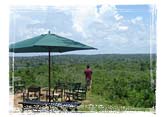
Accommodation:
The former Paraa Rest
Camp is situated on the south side of the Nile, in a patch of bush frequented
by Warthog, Bushbuck and a wide variety of birds. The accommodation is in
self-contained and brick bandas provided with electricity, fans and mosquito
nets. The bar has a fridge and nice views (see photo), and the restaurant serves decent meals. The camp
enjoys a strategic location close to the Paraa Jetty, just 500 metres away. (Category: budget).
Budongo Forest
Budongo Forest Reserve covers
790km2 and is one of the most extensive and ecological diverse in
East Africa, with impressive buttressed giant mahoganies reaching up to 60m
tall. The population of 800 chimps is the largest in Uganda. 366 bird species
has been recorded, among them 60 west or central Africa specials. The Royal
Mile is regarded by some as the single best birdwatching site in Uganda. The
main road past Busingiro also offers superb birdwatching.
Kanyiyo Pabidi Forest
is the second largest
of the four forest blocks within the Budingo Forest Reserve. It covers 268km2
and is an extension of the main Budongo Forest. The two forests are linked by a
forested corridor crossing the Paraa road. It has never been logged and
therefore contains a higher proportion of large buttressed trees. A good place
for birding is the campsite, were Puvel’s Illadopsis is very common.
Semliki National Park
This 220km2
NP was gazetted in 1993, prior to which it was more widely known as the Bwamba
Forest. Situated within the Albertine Rift at an average altitude of around
700m, the NP is bounded to the NW by the Semliki River, which runs along the
Congolese border into Lake Albert, and to the east by the Fort
Portal–Bundibugyo road. The forest is practically unspoilt and is an
extension of the vast Congolese Ituri Forest that stretches all the way to the
Congo River.
Considering its small
size it protects an extraordinary faunal diversity. 435 bird species, most of
them forest birds, and roughly 45 species that occur nowhere else in Uganda.
The mammal list of 35
is far for complete, including no nocturnal primate or small carnivore. 11
mammal species in the list occur nowhere else in Uganda.
Trails: Kirumia River
Trail, Mungiro Waterfall Trail and Sempaya Hot Springs Trail.
The 5 km stretch of the
main road between Sempaya and Ntandi is also excellent, with better views than
in the forest.
Tourist attractions in
the area are the Sempaya hot springs and the Ntandi pygmy village.
There is basic lodging
in Kirimia (Kirimia Guesthouse) and the NP Bandas and Campsite halfway between
Sempaya and Ntandi. A better option for birdwatchers though (who wants to get
into the forest early) is to stay at a decent hotel is in the village
Bundibugyo, 10 km from Kirimia.
Accommodation:
Hotel Vanilla. The newest and best option in Bundibugyo, 7 clean s/c rooms plus
rooms using common showers. Amenities:
Local restaurants offer standard
meals in town. The market has basic foodstuffs on sale and locally grown fruit.
Sodas and beers are also readily available. At night the town plunges into
complete darkness. There is no electricity supply in town.
If you instead stay at
Semliki Safari Lodge in Semliki WR, probably the most luxurious bush retreat in
Uganda, you have to drive at least 90 minutes to get to Kirimia, longer after
rains.
Semliki Wildlife Reserve
This 545km2
sanctuary, Uganda’s oldest wildlife reserve, was originally gazetted in 1932 as
the Toro Game Reserve. The dominant vegetation type is open acacia-combretum
woodland and grassy savanna, interspersed with patches of borassus palm
forests, significant belts of riparian woodland along the main watercourses, as
well as some extensive swamps towards Lake Albert.
Semliki’s wildlife was
heavily poached during the civil war, and it only really started to recover
from the slaughter following the opening of Semliki Safari Lodge in 1997.
As an example, Uganda
Kob had an estimated population of more than 10 000 before the Amin era,
plummeted to below 1 000 in the early 90’s, but today number about 8 000. In
general, game viewing is more impressive in Queen Elisabeth and Murchison Falls
national parks. If time permits we will visit this reserve, but probably not, since we will concentrate our efforts on the many specialities in Semliki NP.
Kibale Forest National Park
This park probably has
the greatest variety of primates (13 species) in all East Africa. Gazetted in
October 1993, the 766km2 NP extends southward from Fort Portal to form a contiguous
block with the Queen Elisabeth NP. Interspersed with patches of grassland and
swamp, the dominant vegetation type is rainforest, spanning altitudes of
1100-1590m and with a floral composition transitional to typical eastern
Afro-montane and western lowland forest.
There are at least 60
species of mammals, but many of these are hard to spot in the forest.
Roughly 335 bird
species have been recorded in Kibale Forest, including four species not
recorded in any other Ugandan park: Nahan’s Francolin, Cassin’s Spinetail,
Blue-headed Bee-eater and Masked Apalis. Otherwise the avifauna reminds of
Semliki, except 40 Semliki specials and adding a higher variety of water and
grassland species. Green-breasted Pitta was sighted here recently, while
Prigogine’s Ground Thrush was collected once in the 1960s. The best
birdwatching spot is the Bigodi Wetland Sanctuary.
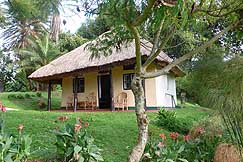
Accommodation:
Chimpanzee Guest
house. Located just inside the NP, 23 km from Fort
Portal and 10 km from Kanyanchu Tourist Centre. 500m from the NP HQ. Panoramic
view from the 100-acre site. Established in the 1950s, during the colonial
period by the British District Commissioner. Accommodation in twin bed bandas
or in self-contained cottages.
Queen Elisabeth National
Park
Uganda’s most popular
and accessible savanna reserve. 1978km2. 95 mammal species, among
them 10 primates and 20 predator species. More than 610 bird species have been
recorded, possibly the highest for any NP in Africa. 54 raptors, all Ugandan
waterbird species and a variety of woodland and forest birds are found.
Accommodation:
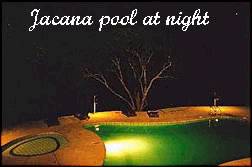
Jacana Safari Lodge. In the SE sector.
Own by geolodges, who also run Nile Safari Camp in Murchison Falls and the new
Mabira Lodge. 8 luxurious wooden doubles with private verandas overlooking the
crater lake Nyamusingire, and the bar and restaurant is suspended over the lake. Pool. Reasonably priced. Good food. (Category: upmarket).
Bwindi Impenetrable National
Park
This forest is regarded
to be one of the most biologically diverse forests in Africa, largely due to
its age (before the Pleistocene Ice Age, making it over 25 000 years old).
Altitude 1160-2607m. A true rainforest, with annual rainfall of almost 1500mm.
Slightly more than half
of the world’s mountain gorilla population is resident in Bwindi: an estimated
320 individuals living in 15 troops.
There are at least 120
mammal species, most of them smaller mammals such as rodents and bats.
350 bird species,
almost all forest species, is a remarkably high figure.
Accommodation at Ruhija:
The Institute of Tropical Forest Conservation (ITFC)
Guest house is the only option in Ruhija. The small hotel has two four-bed
rooms with basics outside the building. At 2340 metres it can get chilly.
Ruhija was the
headquarter for the Impenetrable Forest Reserve before it was gazetted NP in
1991. Few tourists come here, and it is a quet and beautiful place.
Accommodation at Buhoma:
Buhoma Community Rest Camp. Inside the
entrance. 6 bandas of different class, all with solar-powered light. Basic
3-course dinners can be ordered in advance. (Category: budget).
Mgahinga Gorilla National
Park
Mgahinga NP protects
the Ugandan part of the Virunga Mountains. It is the smallest NP in Uganda,
only 33km2, but is connected to similar reserves in DRC and Rwanda.
There are 76 species of mammals and only 115 bird species, probably due to the
parks small size and lack of serious study of the avifauna. But 12 Albert rift
endemics occur.
No gorillas live
permanently in the park, despite its name, but they move freely between Rwanda
and Uganda.
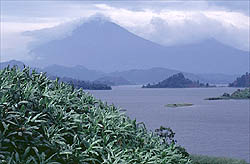
Accommodation in Kisoro:
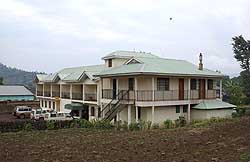
Kisoro Tourist Hotel. 15 rooms. New
multi-storey hotel in a grassy compound close to the NP office. Large bright
rooms, TV, hot showers and balcony. (Category: moderate).
Echuya Forest Reserve
Extending over 340 km2
of hilly terrain at an elevation 2200-2600m Echuya is one of the least-visited
and most under-researched reserves in Uganda, yet it is still ranked among the
top 6 sites in the country in terms of forest biodiversity. A surprisingly low
bird list of 100 species suggests that more work here is needed. The adjacent
Muchuya Swamp harbours the largest known population of Grauer’s Swamp Warbler.
Lake Maburo National Park
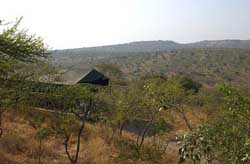
One of Uganda’s smaller
national parks, Lake Mburo extends over 260 km2 of undulating
territory with an altitude of 1220 – 1828 m. The annual rainfall of 800
mm is relatively low, but 20 % of the park is wetland. The remainder of the
park consists of open savanna and acacia woodland. Good place for
acacia-associated birds and papyrus specialists. 315 bird species recorded.
Accommodation:
Kimbla-Mantana Tented Camp. This is a
classic luxury tented camp. 9 walk-in tents on raised wooden platforms with
great views. Full breakfast, 3-course lunches, and 5-course dinner. (Category: upmarket).
Mabamba Swamp

15 km west of Entebbe,
but 40 km by road. 100 km2 of shallow, marshy bay on the northern
shore of Lake Victoria. The villagers at the small lakeshore village of Mabamba
offer dugout trips into the swamp and are usually capable of locating shoebills
within a few minutes.
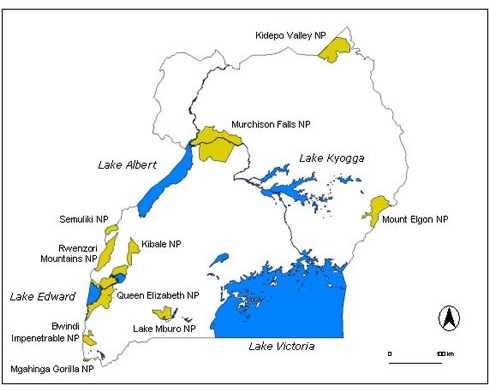
Localities in Rwanda
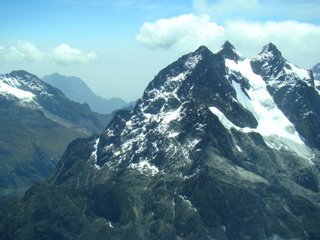
Volcanoes National Park
(Parc National des Volcans)
Little information is available on the current status of other mammals than the gorillas, and the bird list from 1980 is only 180, but a survey in 2004 gave 15 new. A local speciality is the vulnerable swamp-dwelling Grauer's Rush Warbler, while at least 16 Albertine Rift endemics are present, including Handsome Francolin, Rwenzori Turaco, Rwenzori Double-collared Sunbird, Rwenzori Batis, Strange Weaver, Dusky Crimson-wing, Collared Apalis, Red-faced Woodland Warbler and Archer's Ground Robin.
Gorilla tracking remains the most poular activity here, with a total of up to 40 permits issued daily, eight for each of the five habituated troops. There is also a habituated troop of the near-endemic Golden Monkey.
It is 13 kilometres between the park HQ at Kinigi and Musanze/Ruhengeri.
Accommodation in Musanze (formerly Ruhengeri):
Moderate:
Hotel Muhabura (15 rooms). The smartest
hotel in town. Doubles and apartments.
Palmer Hotel (no info).
Centre Pastoral Notre Dame de Fatima (35 rooms). Opened 2004. Clean.
Internet café.
Luxury: Ikoro Tented Camp, due to open in 2007.
There are at least 6 budget hotels also.
Nyungwe Forest National Park
Extending for 970 km2 over the mountainous southwest of
Rwanda, Nyungwe protects one of the largest tracts of montane forest remaining
anywhere in East or Central Africa, forming a contiguous forest block with the
370 km2 Kibara NP in Burundi. As comparison the Gishwati Forest in
NW Rwanda has diminished from the
size of Nyungwe to only 6 km2!
The biodiversity is extremely high. Some examples: Over 1050 plant
species, including 200 orchids and 350 Albertine Rift endemics. 85 mammal, 278
bird, 32 amphibian and 38 reptile species, 120 butterfly species. 13 species of
primates, with a population of at least 500 chimpanzees. The annual
precipitation is over 2 000mm. The elevation is between 1 600m and 2950m.
Nyungwe is probably the single most important birdwatching destination
in Rwanda, with more the 280 species recorded, of which the majority are forest
specialists, and 26 regional endemics. Birdwatching here can be rather
frustrating, since the vegetation is thick and many birds tends to stick to the canopy up to 60
metres above the ground, but almost everything you see ranks as a good
sighting. There are also 13 species of primates, 25 % of Africas total number of species.
Trails: Uwinka and the coloured trails, the Waterfall Trail, Gisakura
tea estate, Kairanzovu Trail, Bigugu Trail.
Accommodation in Nyungwe:
Gisakura Guesthouse.
Akagera National Park
Rwandas answer to the famous savanna reserves in Kenya and Tanzania,
with warm and low-lying broad-leafed woodland or candelabra euphorbias.
Elevation 1600-1800m.
Poaching has greatly reduced the game, and the most common mammal is
domestic cattle being watered in the lakes. But there is high numbers of
hippos, and you find buffalo, elephant, zebra, giraffe, lion, leopard and black
rhino in the park. Interestingly Akegera has been geographically isolated from
the eastern savannas, which was emphasised by the natural absence of widespread
plains animals such as rhino and giraffe, both of which were subsequently
introduced. Due to human pressure refugees occupied the north part and in 1997
the park size was unfortunately reduced by two-thirds from 2 500km2
to 1 085km2. It now stretches for 60 km along the Tanzanian border
and is about 30 km wide.
But the bird life is phenomenal – the checklist of about 525
species includes a surprising density of raptors and some of Africa’s most
impressive concentration of big waterbirds. The total checklist is 550, but
that was before the 2/3rd reduction of the area. It complements
Nyungwe to such an extent that very few birds recorded in Rwanda aren’t found
at one or other site. Akagere is especially good for waterbirds, papyrus
endemics and Brachystegia woodland
species from southern Africa which reach their northern limit here. There are
probably 15-20 pairs of Shoebill, but they are very difficult to see. There are
malaria mosquitoes in Awatere. Tsetse flies can give a painful (but harmless)
bite. Insect repellents have little effect, but it is worth noting that they
are attracted to dark clothing, especially blue.
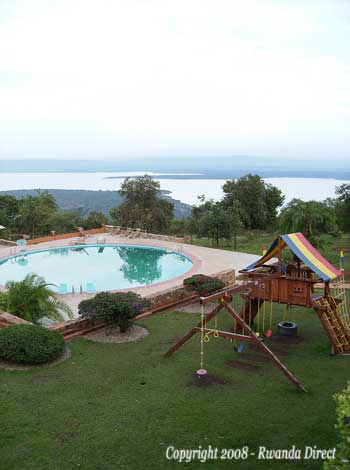
An accurate colour map is sold at the gate. The numbered junctions
shown on the map help with navigation.
Accommodation:
Akagera Game Lodge (former Akagera Hotel) is unfortunately CLOSED in February due to rebuilding. We will stay at a hotel in the town closest to the National Park.
Akagera Game Lodge. 60 rooms. Reopened in 2003. A smart lodge on a
hilltop with superb view over Lake Ihema into the hills of Tanzania. Luxury rooms, good
restaurant, swimming pool and good service. Filling breakfast can be served at
5:30. (Category: upmarket).
